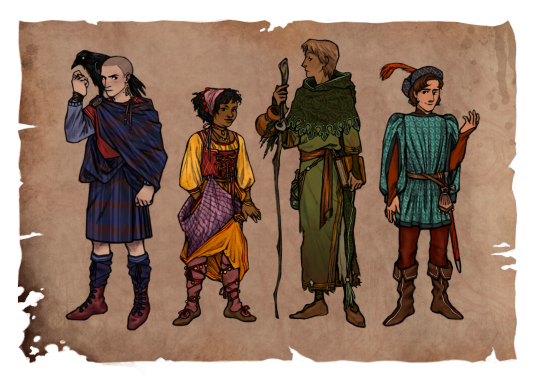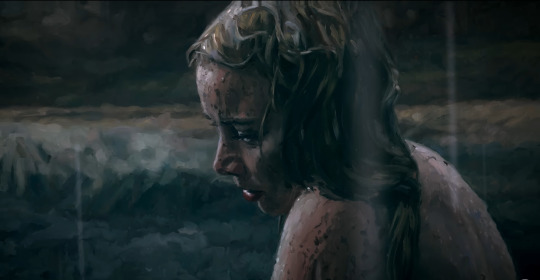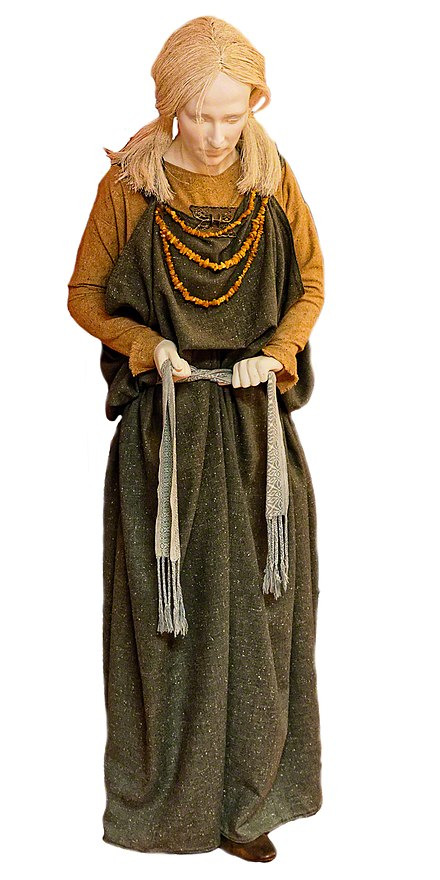#peasant women
Text
Demographers tell us that there has always been a group in each population, estimated as reaching as high as one-third of all women, who were single, that is, not-yet-married, never-married or widowed. Yet, until the 19th century the choice of remaining single was only a choice of one kind of dependency over another. Single women might choose celibacy and the religious life, in which case they depended on their superiors and the male clergy; they might choose celibacy and dependency on male members of their family of origin; they might barely make a living as servant or governess in the household of strangers, in which case their dependency was thorough and humiliating. A single woman might choose the life of prostitution, in which case she could hardly be considered independent, since her very existence depended on the "protection" and sanction of various authorities. A small percentage of all women led economically self-dependent lives on the margins of society (in the Middle Ages literally on the outskirts of towns) as peddlers, vagrants, beggars, thieves. Additionally, there were throughout the period under consideration always a small percentage of single women working as spinsters, brewers, innkeepers and farm workers. There also were propertied widows who could live independent lives, but their properties originated in a prior dependency on a man. For the vast majority of women, marriage and motherhood were their lot and their main means of securing access to resources and economic protection. This was the reason women could not readily concep-tualize bonds of sisterhood or develop a consciousness of common interest through their status as wives.
But motherhood was different, both as an actuality and as a unifying concept. Women shared the life experience of motherhood—frequent pregnancies, miscarriages, births, deaths of children and birth-induced disabilities. Even those who could not conceive did not escape that cycle of female tribulations, since they too were subject to menses, attempted pregnancies, and the ever-present threat of rape. For peasant women who were serfs or domestic servants in the manors of their lords, sexual attack by their masters was a constant and unavoidable threat.
The meaning of motherhood differed for women by class. Until the middle of the 18th century in Europe and the United States, 90 percent of women lived in the countryside, so we should consider peasant women first. The lives of peasant women followed remarkably constant patterns throughout the Christian era despite the vast political and technological changes occurring in the states and nations in which they lived. Peasant women, generation after generation, accepted the double burden of work and reproduction, taking responsibility for the survival of their families and doing whatever work it was necessary to do. Demographers estimate that women's life expectancy was less than that of men in the early Middle Ages, but that it changed dramatically in the 11th century owing to changes in agriculture that brought better nutrition. Still a survey made in the commune of Florence in 1427 shows the average age for men to be 28 years and the average age for women 28.51.
Demographers generally hold that women might have five to seven successful pregnancies during twenty years of their childbearing age; given the life expectancies just cited, four to six successful pregnancies would seem more likely. With the high rate of miscarriages and stillbirths before the 20th century, this meant that a woman would be pregnant or nursing a child for most of her adult lifespan, while working without letup in home and field. Infant mortality rates were high; peasant women could expect half of their children to die before age twenty. Twenty-five percent of children born in England up until the 18th century died in their first year.
Had the average peasant couple produced three adult children out of an average six births, the peasant population of Europe should have grown, but in fact it did not. Only in the aftermath of mass disasters, such as the bubonic plague of the 14th century and the Thirty Years War of the 17th century, did peasant populations increase. This indicates that peasants, living under conditions of bare survival, controlled their birthrates. They did so by delaying the age of marriage, practicing various forms of birth control and, when times were bad, resorting to infanticide, usually the killing of female children. Even though it is impossible to know whether these demographic decisions were made by women or by men and women jointly, one can interpret the overall patterns to mean that motherhood for peasant women was part of their fate—not to become a mother was considered a failure-but also that they exerted some measure of control over the frequency of their pregnancies.
-Gerda Lerner, The Creation of Feminist Consciousness
15 notes
·
View notes
Photo

MWW Artwork of the Day (9/20/22)
Philipp Malyiavin (Russian, 1869-1940)
Peasant Women (1905)
Oil on canvas, 205 x 159 cm.
The Russian Museum, Saint Petersburg
Maliavin introduced a new type of peasant woman into Russian art —- a stately, proud and sometimes intrepidly independent woman. His models were the inhabitants of the villages of Ryazan Province, dressed in bright festive attire. The painting is a sublime and romantic image of Russian womenfolk, with their wholesome characters and inner stature. The two heroines are strong and healthy women, filled with a sense of their own dignity and virtue. They display integrity of character and inner strength. The faces of the girls are meaningful, the looks in their eyes are intent and enigmatic, the colours of their attire glimmer in a bewitching manner. The expressive images are intensified by the artist’s inspired and temperamental painting. Maliavin contributed "Peasant Women" to the World of Art exhibition of 1906 and Sergei Diaghilev’s L’Exposition de l’Art Russe in Paris and Berlin.
For more of this artist's work, see this MWW gallery/album:
https://www.facebook.com/media/set/?vanity=TheMuseumWithoutWalls&set=a.3287892311316115
3 notes
·
View notes
Text

psuedo-medieval fantasy AU ✌️✌️✌️
everyone give it up for ronan's great kilt i had to google so many diagrams to try and figure out how they worked. also big thank you to my mom for gansey's dumb hat btw she was like 'you HAVE to keep the dumb hat'
#trc#my excuse for any historical inaccuracy here is that they're all actually just at a REALLY pretentious renfaire#i DID use references though blue's hiked skirts have historical precedent for peasant women as long as there were hose beneath#i will say the exposed stays are Inexcusable and Not Period but w/e. also she should not be showing that much hair.#also ronan's not wearing black bc black clothing was really hard to produce in the 1400s or whenever the fuck bc it took so much dye#ronan lynch#adam parrish#blue sargent#richard gansey#my art
352 notes
·
View notes
Text

The Peasants dir. Dorota Kobiela, Hugh Welchman (2023)
#The Peasants#Dorota Kobiela#Hugh Welchman#Codirected#2023#Film poster#Poland#Lithuania#Serbia#Ukraine#52 films by women#directed by women#women in film
676 notes
·
View notes
Text
Very interesting (concerning) that while there’s a general consensus of “of course there’s queer Muslims and Jews and Christians we love them!” But that love is conditional. You can be religious but not too religious. You can be spiritual as long as it’s not actually that important to you. You can be observant of your religion’s dogma and traditions as long as you keep it away from everybody else.
But I don’t want to cut myself into smaller pieces. I don’t want to take a part of my life and culture and being and hide it away behind closed doors. It’s just…hypocritical and disappointing when people, who clamor about their love for the contradictory and self-authentic, hate when they’re confronted with it.
#tower of babble#catholic#lgbt#side b#sorry I saw a very good post pointing out the way queer Jews are often cited with the caveat that they’re not observant Jews#and how there are queer observant Jews but I didn’t want to derail so I made my own post#because fuckin hell how often do you see white queers telling queer Muslim women to stop wearing their hibjabi (unless it’s for ~cultural~#purposes). it’s disgusting and demeaning to assume queer people don’t have deeply meaningful spiritual lives.#side b Christians 🤝 observant queer Jews 🤝 devout queer Muslims#me. happily trans and gay: I’m so happy and blessed to have this body and life -#homo/transphobes: you’re going to hell you’re evil you’re stupid you’re faking it#me: huh. oh. um. well I’m still blessed because I know you are not speaking with Christ in your heart-#a surprising number of self proclaimed radicals: uhhhh please don’t acknowledge that you’re Christian it makes us. uncomfortable.#me: …being uncomfortable and confused about others is the pride of Pride? the queer community thrives on contradiction and self definition?#anyways. prof put my pronouns down as he/she/they on the syllabus and I am popping the biggest gender affirming bottles tonight#(praying a chaplet and eating rice like the grad student peasant I am)
425 notes
·
View notes
Text

Laureano Barrau Buñol (Spanish, 1863-1957)
Women weeding the field, 1891
Museo Nacional del Prado, Madrid
#Laureano Barrau Buñol#spanish art#women weeding the field#1800s#clogs#peasant#art#fine art#european art#classical art#europe#european#fine arts#europa#mediterranean#oil painting#spanish#spain#espana#madrid#country#cottage core#country life
57 notes
·
View notes
Text



chłopi (2023), dir. dk welchman & hugh welchman
#chłopi#dk welchman#hugh welchman#dorota kobiela#mine#movies#chlopi#the peasants#non english speaking movies#directed by women#three pieces#top 10
234 notes
·
View notes
Text
'WHY did women fight for the right work haha' omg ur so quirky and funny haha. Hahahahah. So original, never heard this one before. But since its so funny i cant even treat it as a joke ill explain its because when ur financially dependent on the husband he has power over you and you wont be able to leave him no matter what he does with no money of your own. You are straight up property they can buy and take for granted. Thats why probably
#i have no idea what they even mean by 'not working' being of peasant/farmer ancestry myself either#fuck do u think farmer women were doing for centuries? housework only and entire farm was managed by the husband? lmao#can social media leave this crap behind in 2023 its insufferable
18 notes
·
View notes
Text


160 - Hi. I started reading light novels. Keep getting stuck on the most throw-away plot points.
#Hey Anna. I don't get how you're relettering that entire book by hand for a 2nd time when writing the title text for this almost killed me.#light novel#'lace has caught on with peasant women' HOW. HOW COULD THEY POSSIBLY AFFORD THAT CRAFTSMANSHIP?!#IS YOUR ECONOMY THAT GRAND?#even if they made the lace themselves how would they have time to do so?#oh the heroine picked up some lace THAT SHE JUST HAD ON HAND?! and started sewing it on to a skirt?!#But yeah reading novels on your phone turns out to be pretty enjoyable. I get why all those heroines wander into the road now#otome games less so but i just can't stand the dudes in any of them. like they have so much going on. i can't deal with them.#and so many of them are just really mean assholes. like fuck off you don't get to treat the mc that way. go work on yourself
71 notes
·
View notes
Text

Peasant women from Uskub, modern-day Skopje, North Macedonia
Serbian vintage postcard
#old#postcard#postkaart#peasant#modern-day#north macedonia#serbian#women#day#vintage#briefkaart#postal#ansichtskarte#uskub#skopje#ephemera#photography#photo#north#modern#postkarte#tarjeta#macedonia#historic#sepia#carte postale
16 notes
·
View notes
Text
I'll never forget that time that I read a book that was a retelling of Beowulf from the POV of his Grendel's mother.
Okay, okay, normal enough, normal enough. Possibly a nice way of adding a little bit of a female perspective to a story that can be a little bit lacking in that department goo--
Except for, besides being very weird in general and going with the idea of Women's Oppression™ Throughout History Looked Exactly The Same And Resembled Something From A Bad Fantasy Book, it gave me Grendel's mother hating dresses because they restricted her work in the fields.

*So restrictive*
You can't even FIT Corset Discourse on here because this is before the corsets even EXISTED as garments. This is before the GRANDMA of corsets existed as a garment. A woman at this point in time is not wearing RADICALLY more cloth than a man, honestly. You are functionally wearing a pretty loose fitting dress and then something over it that is also loose fitting.
#do people think that historical peasant women/otherwise employed women were just suffering in their Restrictive Dresses#unable to move around#not able to contribute to the household#or only being able to do so through immense discomfort?
25 notes
·
View notes
Text
BABE WAKE UP NEW CHŁOPI CLIP IS OUT ON YOUTUBE AND IT'S ONE OF MY FAVORITE SCENES IN THE WHOLE MOVIE YAHOOO
youtube
#fucking its so so good#the way how not only Jagna looks upset but every women there as well#how this procedure of marrying just for the land is so deeply rooted in their culture#they cannot do anything about it#they just can let tradition going amd make it feel at least a little bit beautiful with their singing#its just so fucking good#like this feeling of helplessnes and understanding#it makes me wanna cry honestly#no chłopi posting is not over when its out on digital im going to be a BEAST#chłopi 2023#chłopi dorota kobiela#the peasants#Youtube
13 notes
·
View notes
Text

Clothing of the Ankara Vilayet
Bashi-bozouk/Mercenary soldier
Muslim shepherd
Married Muslim peasant woman
Istanbul, Turkey, 1873
Pascal Sébah
#ankara#Asian#Istanbul#turkey#Europe#1870s#19th century#Pascal Sébah#men#women#people#Muslim#Islam#black and white#sepia#soldiers#shepherds#peasants#historical#history#world#portrait#traditional
40 notes
·
View notes
Text
Childe's gender is knightcore.
#humanity is separated into knights and peasants#not men and women#that's how he sees it#childe#tartaglia
12 notes
·
View notes
Text

Oh the misogyny is... rancid
#emmerdale spoilers#overall its not like. too bad a storyline by the sounds of things. and we already know how it ends.#but the optics of that picture good lord.#the mighty man standing tall while two broken peasant women reach out their hands begging for the man to save them#I've changed my mind on everything. they both deserve better x
10 notes
·
View notes
Text

Vintage photo of Calabrian peasant women
Follow us on Instagram, @calabria_mediterranea
#calabria#italy#italia#south italy#southern italy#italian#women#italian women#mediterranean#peasants#peasant#vintage#vintage photography#vintage photo#vintage photos
36 notes
·
View notes